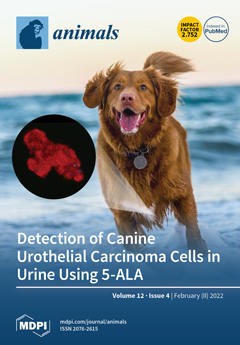Escherichia coli is one of the most common causes of mastitis on dairy farms around the world, but its clinical severity is determined by a combination of virulence factors. Recently, clustered regularly interspaced short palindromic repeat (CRISPR) arrays have been reported as a novel typing method because of their usefulness in discriminating pathogenic bacterial isolates. Therefore, this study aimed to investigate the virulence potential of
E. coli isolated from bulk tank milk, not from mastitis, and to analyze its pathogenic characterization using the CRISPR typing method. In total, 164 (89.6%) out of 183
E. coli isolated from the bulk tank milk of 290 farms carried one or more of eighteen virulence genes. The most prevalent virulence gene was
fimH (80.9%), followed by
iss (38.3%),
traT (26.8%),
ompT (25.7%),
afa/draBC (24.0%), and
univcnf (21.9%). Moreover, the phylogenetic group with the highest prevalence was B1 (64.0%), followed by A (20.1%), D (8.5%), and C (7.3%) (
p < 0.05). Among the four CRISPR loci, only two, CRISPR 1 and CRISPR 2, were found. Interestingly, the distribution of CRISPR 1 was significantly higher in groups A and B1 compared to that of CRISPR 2 (
p < 0.05), but there were no significant differences in groups C and D. The prevalence of CRISPR 1 by virulence gene ranged from 91.8% to 100%, whereas that of CRISPR 2 ranged from 57.5% to 93.9%. The distribution of CRISPR 1 was significantly higher in
fimH,
ompT,
afa/draBC, and
univcnf genes than that of CRISPR 2 (
p < 0.05). The most prevalent
E. coli sequence types (EST) among 26 ESTs was EST 22 (45.1%), followed by EST 4 (23.2%), EST 16 (20.1%), EST 25 (19.5%), and EST 24 (18.3%). Interestingly, four genes,
fimH,
ompT,
afa/draBC, and
univcnf, had a significantly higher prevalence in both EST 4 and EST 22 (
p < 0.05). Among the seven protospacers derived from CRISPR 1, protospacer 163 had the highest prevalence (20.4%), and it only existed in EST 4 and EST 22. This study suggests that the CRISPR sequence-typing approach can help to clarify and trace virulence potential, although the
E. coli isolates were from normal bulk tank milk and not from mastitis.
Full article






